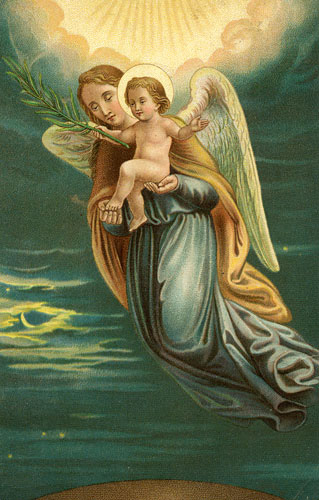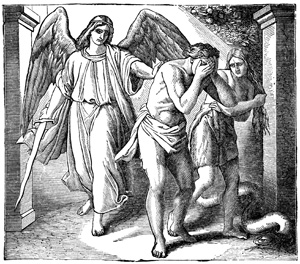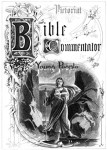By Karen, on October 2nd, 2010
 Archangels Archangels
The Seven Who in God’s presence, nearest to His throne, Stand ready at command. — Milton.
There are several angels who in artistic representations have assumed an individual form and character. These belong to the order of Archangels, placed by Dionysius in the third Hierarchy: they take rank between the Princedoms and the Angels and partake of the nature of both. Like the Princedoms, they have Powers; and, like the Angels, they are Ministers and Messengers. Frequent allusion is made in Scripture to the seven Angels who stand in the presence of God. (Rev. viii. 2, xv. 1, xvi. 1, etc.; Tobit xxii. 15.) This was in accordance with the popular creed of the Jews, who not only acknowledged the supremacy of the Seven Spirits, but assigned to them distinct vocations and distinct appellations, each terminating with the syllable El, which signifies God. . . . → Read More: Archangels: Part 1
By Karen, on September 11th, 2010

Triumph of the Innocents by Holman Hunt
[Part 1] [Part 2] [Part 3] In this front rank of great religious artists we must also place Mr. Holman Hunt, whose work has appealed so strongly to the popular mind, without any deliberate attempt on his part, however, to make it do so. His great picture, “The Triumph of the Innocents,” demands mention here for the beauty of the angelic children who, seen alone by the infant Christ, are accompanying the Holy Family to Egypt. The picture was at the Guildhall Exhibition a year or two ago, and is now in the Walker Art Gallery, Liverpool. . . . → Read More: Angel Art: Part 4
By Karen, on September 10th, 2010

Guardian Angels
At the close of the previous article [Angel Art – Part 2] I ventured to express the opinion that we should find the most successful modern artists who have pictured the angelic form to be those who have worked in the same simple spiritual manner as did the Pre-Raphaelite Italian painters. The religious ideal in art has been seldom attained: it demands something more than mere technical skill: the quietude of life, the purity of thought, the calm faith which Fra Angelico cultivated, are needed to produce the proper state of mind to direct the physical power of the work. There have been many modern painters who have set themselves to paint religious pictures, but those to whom success can be attributed are few. . . . → Read More: Angel Art: Part 3
By Karen, on August 22nd, 2010

Heavenly Angels
Bearing these remarks in mind, [Angel Art: Part 1] let us examine the pictorial representations of angels by the early masters in art. It is necessary, too, to remember that Christian art at the first was directed and controlled by the Church. Art was bound to the service of religion: all its life and force were expended upon it, and, indeed, the workers themselves were, for the most part, until the thirteenth century, of the Church. We cannot touch upon the crude productions of the very early artists, and can only barely refer to the culmination of their art as exhibited in illuminated manuscripts. The beauty and delicacy of these decorated parchments are wonderful. With the use of the primary colours and gold, these, to us nameless, workers produced miniature pictures the charm of which—more than six centuries after their creators have passed away—still enthralls us. . . . → Read More: Angel Art: Part 2
By Karen, on August 21st, 2010
 Adam and Eve Pictures Adam and Eve Pictures
From The Quiver, “Picturing the Angels” by Arthur Fish: And He placed at the east of the garden of Eden cherubims, and a flaming sword which turned every way, to keep the way of the tree of life.” This, the first reference in Scripture to the heavenly hosts, brings involuntarily to the mind’s eye of the reader a conception more or less clearly defined of the angelic guardians of the gates of Paradise. From whence has this idea sprung? Not from the Bible itself . . . . . . → Read More: Angel Art: Part 1
By Karen, on August 18th, 2010
 For my very first post, I wanted to share excerpts from two books that eloquently express why Biblical Art can enhance our understanding and appreciation of the Bible.
From The Teachers’ and Students’ Encyclopedia by Patrick Fairbairn:
Special care and attention have been given to the preparation of the illustrations, of which about seven . . . → Read More: Biblical Art
|
|
|





Archangels: Part 1
There are several angels who in artistic representations have assumed an individual form and character. These belong to the order of Archangels, placed by Dionysius in the third Hierarchy: they take rank between the Princedoms and the Angels and partake of the nature of both. Like the Princedoms, they have Powers; and, like the Angels, they are Ministers and Messengers. Frequent allusion is made in Scripture to the seven Angels who stand in the presence of God. (Rev. viii. 2, xv. 1, xvi. 1, etc.; Tobit xxii. 15.) This was in accordance with the popular creed of the Jews, who not only acknowledged the supremacy of the Seven Spirits, but assigned to them distinct vocations and distinct appellations, each terminating with the syllable El, which signifies God. . . . → Read More: Archangels: Part 1